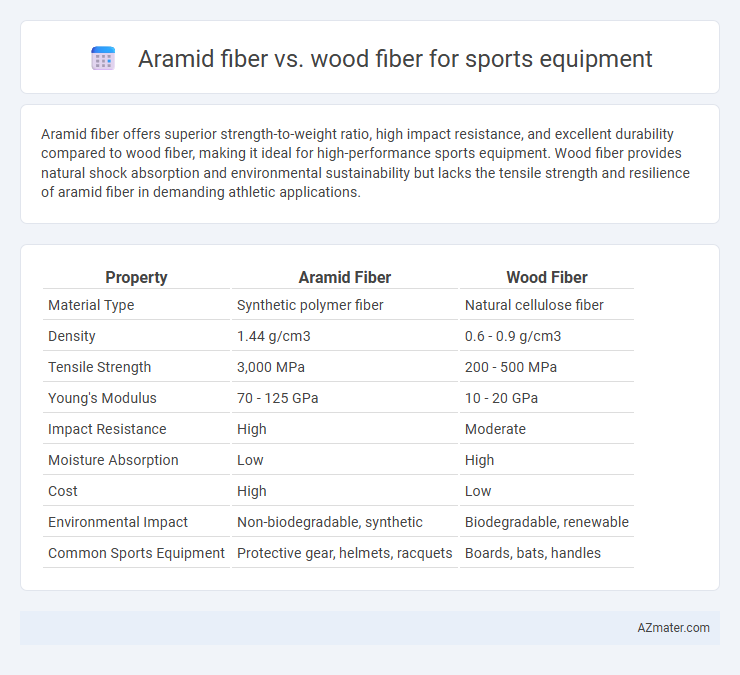Aramid fiber offers superior strength-to-weight ratio, high impact resistance, and excellent durability compared to wood fiber, making it ideal for high-performance sports equipment. Wood fiber provides natural shock absorption and environmental sustainability but lacks the tensile strength and resilience of aramid fiber in demanding athletic applications.
Table of Comparison
| Property | Aramid Fiber | Wood Fiber |
|---|---|---|
| Material Type | Synthetic polymer fiber | Natural cellulose fiber |
| Density | 1.44 g/cm3 | 0.6 - 0.9 g/cm3 |
| Tensile Strength | 3,000 MPa | 200 - 500 MPa |
| Young's Modulus | 70 - 125 GPa | 10 - 20 GPa |
| Impact Resistance | High | Moderate |
| Moisture Absorption | Low | High |
| Cost | High | Low |
| Environmental Impact | Non-biodegradable, synthetic | Biodegradable, renewable |
| Common Sports Equipment | Protective gear, helmets, racquets | Boards, bats, handles |
Introduction to Fiber Materials in Sports Equipment
Aramid fiber exhibits exceptional strength-to-weight ratio and high tensile strength, making it ideal for impact-resistant sports equipment such as helmets and protective padding. Wood fiber, known for its natural flexibility and shock absorption, is commonly used in traditional sports gear like tennis rackets and baseball bats, offering a sustainable and eco-friendly alternative. The choice between aramid and wood fibers depends on the specific performance requirements, with aramid favored for durability and wood fiber valued for its resilience and environmental benefits.
Overview of Aramid Fiber Properties
Aramid fiber exhibits exceptional tensile strength, high impact resistance, and excellent thermal stability, making it a superior choice for high-performance sports equipment. Its lightweight nature combined with remarkable durability enhances the protective qualities and longevity of items like helmets, racquet frames, and protective gear. Compared to wood fiber, aramid fiber offers significantly better resistance to wear, moisture, and environmental degradation, leading to improved overall performance and safety in sports applications.
Key Characteristics of Wood Fiber
Wood fiber exhibits a natural lightweight structure with moderate tensile strength and excellent shock absorption, making it suitable for sports equipment requiring flexibility and impact resistance. Its biodegradability and renewable nature provide an eco-friendly alternative to synthetic fibers like aramid. However, wood fiber's lower durability and susceptibility to moisture limit its use in high-performance or weather-exposed sports gear.
Strength and Durability Comparison
Aramid fiber offers superior tensile strength and impact resistance compared to wood fiber, making it ideal for high-performance sports equipment demanding durability. Wood fiber, while renewable and lightweight, generally exhibits lower strength and is more prone to wear and environmental damage over time. The enhanced molecular structure of aramid fibers contributes to longer lifespan and consistent performance under stress, outperforming wood fiber in strength and durability metrics.
Weight and Flexibility Differences
Aramid fiber offers significantly lower weight and higher flexibility compared to wood fiber, making it ideal for high-performance sports equipment like tennis rackets and bicycle frames. Wood fiber provides natural rigidity and moderate weight but lacks the tensile strength and elasticity found in aramid composites, resulting in heavier yet less flexible gear. The superior strength-to-weight ratio and enhanced flexibility of aramid fiber improve durability and responsiveness in sports applications, outperforming traditional wood fiber materials.
Impact Resistance in Sports Applications
Aramid fiber offers superior impact resistance compared to wood fiber, making it ideal for high-performance sports equipment such as helmets and protective gear. Its molecular structure provides exceptional energy absorption and durability under repeated stress, enhancing athlete safety and equipment longevity. Wood fiber, while eco-friendly and lightweight, lacks the resilience and toughness of aramid fiber in high-impact scenarios, limiting its use in protective sports applications.
Environmental and Sustainability Considerations
Aramid fiber offers high durability and resistance to wear, which extends the lifespan of sports equipment and reduces waste, but its production involves non-renewable petroleum resources and generates greenhouse gas emissions. Wood fiber, being a renewable and biodegradable material, supports sustainable forestry practices and has a lower carbon footprint, making it an eco-friendlier option for sports gear. Choosing wood fiber promotes carbon sequestration and end-of-life compostability, contrasting with the energy-intensive recycling challenges and potential environmental hazards of aramid fiber disposal.
Cost Analysis: Aramid vs Wood Fiber
Aramid fiber sports equipment commands a higher initial investment due to its advanced manufacturing process and superior performance characteristics, including exceptional strength-to-weight ratio and durability. Wood fiber, being more abundant and easier to process, offers a cost-effective alternative with moderate durability and weight, making it suitable for budget-conscious applications. When evaluating lifecycle costs, aramid fiber's longer lifespan and reduced maintenance can offset its upfront expense, whereas wood fiber may require more frequent replacements, increasing long-term expenditures.
Performance in Popular Sports Gear
Aramid fiber offers superior tensile strength and impact resistance, making it ideal for high-performance sports equipment such as helmets, protective gear, and racing components. Wood fiber, while more sustainable and providing natural shock absorption, is primarily used in traditional sports gear like baseball bats and hockey sticks due to its moderate durability and flexibility. In terms of performance, aramid fiber significantly enhances durability and weight reduction, which directly improves athlete safety and agility in competitive sports.
Which Fiber Is Best for Modern Sports Equipment?
Aramid fiber offers superior strength-to-weight ratio, impact resistance, and durability compared to wood fiber, making it ideal for modern sports equipment requiring high performance and longevity. Wood fiber, while sustainable and naturally shock-absorbent, lacks the consistent tensile strength and flexibility needed for advanced gear such as racquets and protective helmets. The advanced mechanical properties of aramid fibers, especially Kevlar, ensure enhanced speed and control, positioning it as the preferred material for cutting-edge sports technology.

Infographic: Aramid fiber vs Wood fiber for Sports equipment
 azmater.com
azmater.com